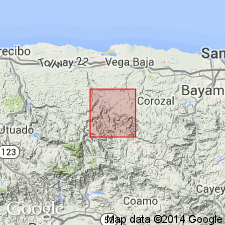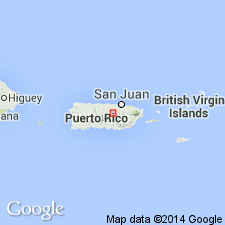
- Usage in publication:
-
- Avispa Lava Member*
- Modifications:
-
- Overview
- Dominant lithology:
-
- Lava
- AAPG geologic province:
-
- Caribbean region
Summary:
The Avispa Lava Member (Lidiak, 1965) of the Rio Orocovis Formation is here adopted by the USGS. Consists of andesitic pillow lava and minor reworked tuff, conglomerate, volcanic breccia, and reef limestone. Highly deformed and faulted in places. Unconformably overlies the Perchas Member of the Rio Orocovis in south-central Ciales quadrangle; base is not exposed elsewhere. Conformably underlies the Manicaboa Formation. Thickness ranges from 100 to 1,500 m. Age is Turonian(?) to late Santonian(?) or early Campanian.
Source: GNU records (USGS DDS-6; Reston GNULEX).

- Usage in publication:
-
- Avispa Formation*
- Modifications:
-
- Revised
- AAPG geologic province:
-
- Caribbean region
Summary:
Rio Orocovis Formation redefined Rio Orocovis Group and Avispa Lava Member redefined Avispa Formation. A lenticular unit of interbedded volcanic breccia, sandstone, and siltstone that separates lava flows in the lower and upper parts of the Avispa is named the Cuchillas Member. Avispa is 1,800 m thick in Corozal quadrangle. Conformably overlies the Perchas Formation; conformably underlies the Los Negros Formation.
Source: GNU records (USGS DDS-6; Reston GNULEX).

- Usage in publication:
-
- Avispa Formation*
- Modifications:
-
- Overview
- AAPG geologic province:
-
- Caribbean region
Summary:
The Avispa Formation occurs in central Puerto Rico and consists of pillowed lava flows and interbedded tuffaceous sandstone, some volcanic breccia and conglomerate, and a local calcarenite. Maximum estimated thickness is 1800 meters. The Avispa is of Late(?) Cretaceous age.
Source: GNU records (USGS DDS-6; Reston GNULEX).
For more information, please contact Nancy Stamm, Geologic Names Committee Secretary.
Asterisk (*) indicates published by U.S. Geological Survey authors.
"No current usage" (†) implies that a name has been abandoned or has fallen into disuse. Former usage and, if known, replacement name given in parentheses ( ).
Slash (/) indicates name conflicts with nomenclatural guidelines (CSN, 1933; ACSN, 1961, 1970; NACSN, 1983, 2005, 2021). May be explained within brackets ([ ]).

